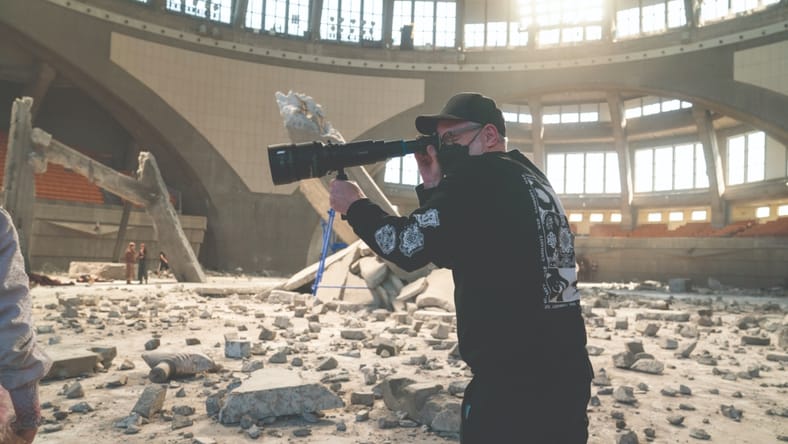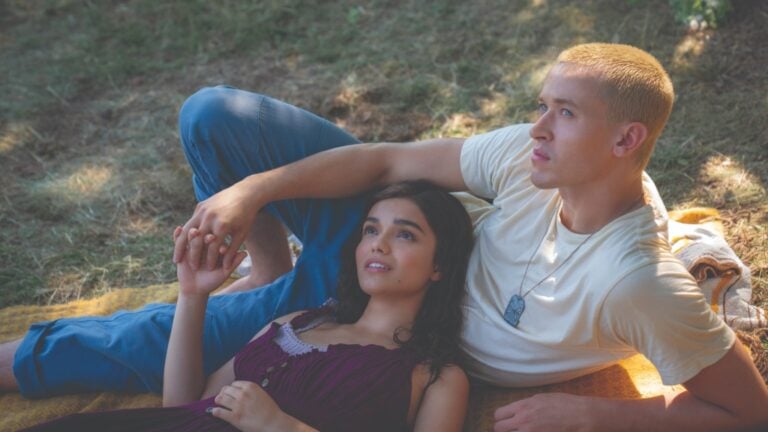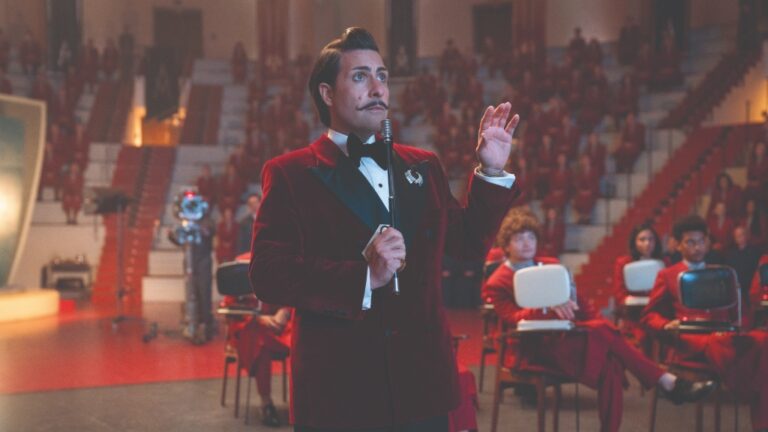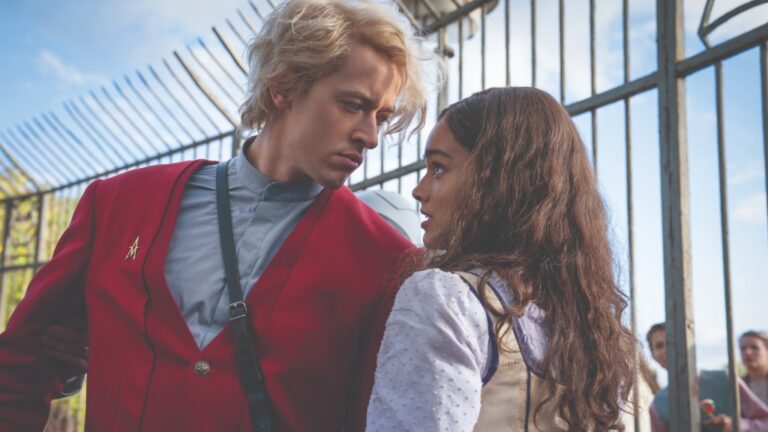
The Hunger Games: The Ballad of Songbirds and Snakes director Francis Lawrence is also the man behind the music videos for some of the most iconic songs of the ‘90s and 2000s, including Shakira’s “Whenever, Wherever,” Avril Lavigne’s “Sk8er Boi,” Nelly Furtado’s “I’m Like a Bird,” Beyonce’s “Run the World (Girls),” Justin Timberlake’s “Cry Me a River,” Jennifer Lopez’s “Jenny From the Block,” and Lady Gaga’s “Bad Romance”.
But his ultimate target was always to direct features.
“I ended up doing music videos for maybe like 12 years or something, and I really lucked into a kind of golden age of videos where the artists were still making money and there were good budgets and people wanted to do some interesting things,” he says.
“In an effort to try to get into movies, I started to focus, when I could, on doing some storytelling in the videos as well as world-building so that I could build a reel toward getting representation for movies and trying to convince executives and producers to give me jobs in the film business.”
Lawrence ended up getting a manager because of his music video work, and that manager happened to also work with Keanu Reeves. That led to Lawrence’s 2005 feature directorial debut, Constantine, starring Reeves as a demon hunter. From there, Lawrence went on to direct I Am Legend starring Will Smith, Water for Elephants starring Robert Pattinson, and then the second through fourth movies in The Hunger Games franchise: Catching Fire, Mockingjay Part 1, and Mockingjay Part 2, all starring Jennifer Lawrence.
When the final installment premiered, he thought he was saying goodbye to The Hunger Games forever — but when Suzanne Collins came calling with a new book, he was happy to let the games begin again with The Hunger Games: The Ballad of Songbirds and Snakes. Here’s what he’s learned in his filmmaking career.
As told to Margeaux Sippell
Also Read: Catherine Hardwicke: Things I’ve Learned as a Moviemaker

The Hunger Games: The Ballad of Songbirds and Snakes Director Francis Lawrence Shares Things He’s Learned as a Movie Maker
- I think everybody has something different to say. Honestly, I came at movies in such a visual way — partially just because I found that appealing from a very young age. It took a while for me to even discover what the common thread was in the movies and stories that appealed to me. And I found that I lean toward stories about very solitary figures. I think everybody has different experiences. Somebody might go through a trauma, and that allows them to tell very specific stories, or somebody might have very specific political belief systems, and I think there was just something inside me that I find appealing about certain kinds of stories that I’m still discovering.
- There’s definitely a learn-as-you-as-you-go element to it. I have to say, having gone to film school, I’m not positive that I would send kids to film school, because you can watch movies and you can watch YouTube, you can also try and make movies with your friends. But I think it’s far more important to be studying literature and to be studying history, and to be studying photography and other fine arts, because I think those kinds of influences are far more important than just the technicalities of making a movie, of how to record sound or how to operate a camera. I mean, certainly, you want to watch movies and love movies and think about what makes good movies. But I think literature and history are far more important.
- Both of my parents were math people. My mother’s a statistician and my dad was a physicist, and I think they were sort of shocked that I went the creative route. I don’t really have artists in my family. I saw the most movies with my dad. He was a movie guy and would take me to movies all the time. Family-wise, he was probably a big influence, just because he exposed me to so many different kinds of movies. My parents split up when I was a teenager, and so when I’d spend time with my dad, we would see movies. So we saw everything, and I am pretty convinced that that’s kind of what sent me into and toward film school. It was in those teen years that I really discovered that moviemaking was not just entertainment — it was an art form.
- So many of the people that I work with, I’ve worked with for a long time. A lot of the people in my group I met in the music video days. The cinematographer that I’ve used since Catching Fire, so for five or six movies, is a guy named Jo Willems who I met in 2000. We did a video for P.O.D., which was where we met. We shot that down in Long Beach and he did “Cry Me a River.” We worked together for a long time. And then on Catching Fire when I felt like I had enough cred to suggest an up-and-coming cinematographer to work with on a big movie, I called him in. Same with Trish Summerville, who does costumes for most of the movies that I do. She and I actually met on a P!nk video. She did the “Sk8er Boi” video. We work together a lot. Over time, I’ve found people that I think are really talented.

- I put the most focus on the script phase. I mean, I always put a lot of focus on every phase. But I think the script phase is definitely the one that I put the most focus on. It’s the thing that I work on for the longest. We started working on the script for Ballad of Songbirds and Snakes in early 2020, and we didn’t shoot until 2022. So we spent close to two years working on that script.
- But I have to say that once it’s close to being ready, when it’s a movie, I really enjoy the prep process. I really enjoy starting to make the decisions and seeing it come together. Like, who are going to be the people that I work with? Is there a new production designer, like finding Uli Hanisch, who did Ballad of Songbirds and Snakes with me? Picking locations; the scouting; figuring out that sort of puzzle of that and working with my assistant director on how we’re going to achieve it all — how do you bomb an arena like in Ballad of Songbirds and Snakes? — figuring all that stuff out, I think is really, really fun.
- I also really like post-production, because shooting for me is really stressful. I wake up every morning with a knot in my stomach because you really only have that day to sort of try to get the scenes that are assigned to that day. So many things could go wrong — could be somebody’s personality, could be somebody’s sick, could be something’s broken, or something’s not working, or we didn’t plan something correctly, or it’s raining and you need sun. I mean, there are just all these things, and you have a finite amount of time. I find it so sort of constantly stressful that I don’t really love shooting as much as I wish I did. But post, once you have all the material, it’s kind of nice. You come home and the lifestyle is much more civilized again, and you sit with your editor and you go through it all, and then you see the movie come together in a whole new way. And there’s something really gratifying about that.
- It’s funny — when I did my first film, I knew the perception of me being a music video director was that I would focus on the visuals. And I kind of told myself, OK, I know how to make visual things and I trust my eye and I know I can make things look good. So I’m not going to focus on that — I’m going to focus on the actors and I’m going to focus on the story. And the truth is, the muscles for the visual side of it all still kind of took over. I wish I still would have [stuck to that resolution], even if it’s studying the art of acting and talking to the actors and really breaking down and analyzing scenes and thinking about them in a more human way, as opposed to, ‘How am I going to make this look?’ So I think that would be the advice I would tell myself: Go take some acting classes. When blocking a scene, put yourself in the head of the actors and the characters and don’t think about the cool way a scene can open. Think about the truthful way a scene would open or end emotionally.

- The one mantra that I have that I do go back to — I remember using it for the first time when I did I Am Legend — was that I get so stressed sometimes during shoots that I have to remind myself that it’s supposed to be fun.We all get into filmmaking not for it to be a horrible, painful experience, but because it’s kind of fun, and it can be really magical. There are often times where I will really look in the mirror in the morning after a shower and remind myself that this is supposed to be fun, as a way to start a day with positive energy versus dread.
- I don’t think that this is necessarily a common piece of advice, but there’s a very good, very well-respected filmmaker that I was around at one point, and I was in post on I Am Legend, and he told me, because we’re near the end, ‘At this point, reject everything — any new music that comes in, any visual effects shot that comes in, any sequence that comes in. Because it’ll scare people and keep them on their toes and keep them from being complacent.’ And I don’t believe in that. I’m not gonna say who it was that told me that. There are definitely filmmakers that work this way, who feel that creating fear and chaos creates better work. And that’s something that I don’t believe in. I actually believe that people enjoying themselves rather than being afraid and walking on eggshells creates better work.
- When you get people that are complaining all the time or not organizing things properly or running their departments in very chaotic ways, things like that — that has a huge effect on team spirit and camaraderie. So now I’ve learned you have to be really, really careful with the casting of people — not just the actors, but the people that you’re working with. Finding people that are talented and nice and organized and really vetting whether they’re really championing the project that they’re all working on.
- My favorite thing that I’ve worked on is usually my most recent, and then when it comes down and gets judged, and then I move on to the next one and decide that’s going to be my favorite. Doing so many of the Hunger Games movies is really gratifying, and I’m sure just because it’s such an important franchise for people that it will be something I’ll be remembered for. I think I Am Legend really connected with people. But it’s strange — even Constantine, which kind of just got by financially in the beginning and kind of got shit reviews — now there’s this sort of resurgence. I can’t tell you, when I’ve traveled around the world, how many Constantine DVDs I sign. It’s gotten this sort of cult following. There’s been a call to make a Constantine sequel. It’s this weird thing. You sort of feel this kind of rejection, and then it comes back 20 years later, and that’s kind of gratifying. So even though you go through the pain of like, Oh, wow, people don’t really like that movie — then 20 years later, they’re like, ‘Oh, that movie is great. What are you talking about?’
- I just hope people enjoy the movies that I make and they make an impact. A little story I remember from Constantine — when it came out, because it was my first movie, on opening weekend I went on Friday night to the Grauman’s Chinese Theater, and on Saturday I went to see an evening show at the theater at the Grove here in L.A. And then on Sunday, it was a rainy afternoon, and I went to one of the big theaters in Westwood. There weren’t that many people in the theater, which was kind of a bummer, and there was this couple sitting in front of me and they were making out through the whole thing. I just remember at first being annoyed, like, they’re not seeing any of this. But then I sort of went, You know what, though? This is actually kind of cool because movies are more than just the object that we spend so much time making. For this couple, whether they’re together or not, Constantine will be this memory of making out on some rainy Sunday afternoon with this weird movie playing in the background. And there was something sort of special about it for me. Movies just mean such different things to different people.
The Hunger Games: The Ballad of Songbirds and Snakes is now in theaters.
Main Image: Director Francis Lawrence on the set of The Hunger Games: The Ballad of Songbirds & Snakes. Photo Credit: Murray Close / Courtesy of Lionsgate.

